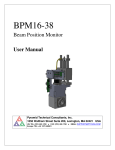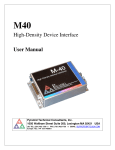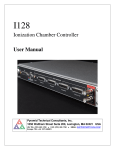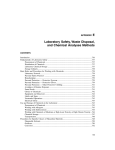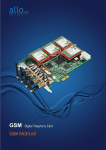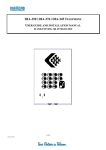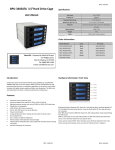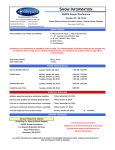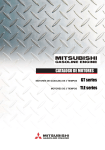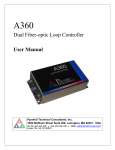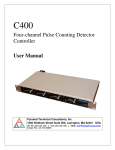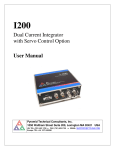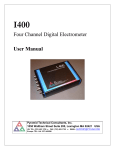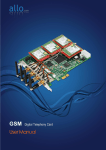Download IC64-16 - Pyramid Technical Consultants
Transcript
IC64-16 Ionization Chamber User Manual Pyramid Technical Consultants, Inc. 1050 Waltham Street Suite 200, Lexington, MA 02421 USA US: TEL: (781) 402-1700 ♦ FAX: (781) 402-1750 ♦ EMAIL: [email protected] Europe: TEL: +44 1273 492001 PSI System Controls and Diagnostics 1 Contents 1 CONTENTS ........................................................................................................................................................2 2 FIGURES ............................................................................................................................................................4 3 SAFETY INFORMATION ...............................................................................................................................5 4 MODELS ............................................................................................................................................................7 5 SCOPE OF SUPPLY .........................................................................................................................................8 6 OPTIONAL ITEMS AND CONSUMABLES .................................................................................................9 6.1 READOUT ELECTRONICS ...................................................................................................................................9 6.2 SIGNAL CABLES AND CABLE ACCESSORIES .......................................................................................................9 6.2.1 Individual cables....................................................................................................................................9 6.2.2 Cable sets ...............................................................................................................................................9 6.3 CONSUMABLES.................................................................................................................................................9 7 INTENDED USE AND KEY FEATURES .....................................................................................................10 7.1 7.2 INTENDED USE ...............................................................................................................................................10 KEY FEATURES ..............................................................................................................................................10 8 SPECIFICATION ............................................................................................................................................12 9 INSTALLATION .............................................................................................................................................18 9.1 PREPARATION AND HANDLING........................................................................................................................18 9.2 MOUNTING .....................................................................................................................................................18 9.2.1 Standard mounting arrangement .........................................................................................................18 9.2.2 Beamline coordinate conventions ........................................................................................................22 9.3 CABLING AND SERVICES .................................................................................................................................22 9.3.1 Electrical connections..........................................................................................................................22 9.3.2 Readout with the I6400 electrometer ...................................................................................................23 9.3.3 Readout with the I128 electrometer .....................................................................................................25 9.3.4 Cable routing .......................................................................................................................................26 9.3.5 Gas connections ...................................................................................................................................26 10 AN OVERVIEW OF THE IC64-16 ................................................................................................................28 10.1 IONIZATION CHAMBERS .............................................................................................................................28 10.1.1 Signal formation..............................................................................................................................28 10.1.2 Pulsed beams ..................................................................................................................................29 10.1.3 Gain calibration ..............................................................................................................................30 10.1.4 Effect of beam trajectory .................................................................................................................32 10.1.5 Recombination ................................................................................................................................33 10.2 POSITION READOUT ...................................................................................................................................34 10.2.1 Beam centroid .................................................................................................................................34 10.2.2 Beam width......................................................................................................................................37 11 ENVIRONMENT SENSORS ..........................................................................................................................38 11.1 READOUT ..................................................................................................................................................38 IC64-16 User Manual IC64-16_UM_141204 Page 2 of 53 PSI System Controls and Diagnostics 11.2 CALIBRATIONS...........................................................................................................................................38 11.2.1 Temperature ....................................................................................................................................38 11.2.2 Pressure ..........................................................................................................................................38 11.2.3 Humidity..........................................................................................................................................39 12 CONNECTORS................................................................................................................................................40 12.1 ELECTRICAL ..............................................................................................................................................40 12.1.1 Integral plane readouts ...................................................................................................................40 12.1.2 Axis A and B signal outputs ............................................................................................................40 12.1.3 Environment sensors .......................................................................................................................42 12.1.4 High voltage inputs and outputs .....................................................................................................42 12.2 FILL GAS ....................................................................................................................................................42 13 MAINTENANCE .............................................................................................................................................43 13.1 PREVENTATIVE MAINTENANCE SCHEDULE.................................................................................................43 13.1.1 HV enable response check ..............................................................................................................43 13.1.2 Offset currents .................................................................................................................................44 13.2 DESICCANT REPLACEMENT ........................................................................................................................44 13.2.1 Procedure........................................................................................................................................44 13.3 CONSUMABLES AND SPARES ......................................................................................................................47 14 FAULT-FINDING............................................................................................................................................48 15 RETURNS PROCEDURE...............................................................................................................................50 16 SUPPORT .........................................................................................................................................................51 17 DISPOSAL ........................................................................................................................................................52 18 REVISION HISTORY .....................................................................................................................................53 IC64-16 User Manual IC64-16_UM_141204 Page 3 of 53 PSI System Controls and Diagnostics 2 Figures Figure 1. IC64-16 dimensions (mm) and mounting face 1. ...................................................................................14 Figure 2. IC64-16 mounting face 2. .........................................................................................................................15 Figure 3. IC64-16 connectors face (nominal beam entry face) .............................................................................16 Figure 4. Section on figure 3 ....................................................................................................................................17 Figure 5. IC64-16 mounting surfaces. .....................................................................................................................19 Figure 6. Additional mounting features. .................................................................................................................19 Figure 7. Beam entrance face in the standard orientation showing connection points. .....................................20 Figure 8. Sequence of electrode foils for nominal beam direction. .......................................................................21 Figure 9. Ion optics standard coordinate convention (Transport code)...............................................................22 Figure 10. Schematic connection arrangement to two I6400-XP20 electrometers. .............................................24 Figure 11. Schematic connection arrangement to two I6400-XP20 electrometers (HV crossed).......................25 Figure 12. Schematic connection arrangement to one I128-XP20 electrometer and an F100. ..........................26 Figure 13. Ionization chamber signal formation. ...................................................................................................28 Figure 14. Signal partition on strip cathodes. ........................................................................................................29 Figure 15. Example simulated pulsed beam response. ...........................................................................................30 Figure 16. Approximate gain curve for the IC64-16, protons in air at SATP (50 – 300 MeV). .........................31 Figure 17. Approximate gain curve for the IC64-16, protons in air at SATP (100-250 MeV)...........................32 Figure 18. Increased path length and ionization from an inclined trajectory. ....................................................33 Figure 19. Example of minimal effect of recombination on peak measurement..................................................34 Figure 20. Beam position in IC64-16 strip electrode coordinates (blue) ..............................................................35 Figure 21. Displacement of IC body coordinates(red) from IC strip electrode coordinates (blue) ...................36 Figure 22. Change to beamline coordinates (green) ..............................................................................................36 Figure 23. Plugging flow gas port for operation with dry atmospheric air .........................................................42 Figure 24. Desiccant chamber location ...................................................................................................................45 Figure 25. Desiccant sac replacement components .................................................................................................46 Figure 26. Ionization chamber in shipping case with protective window covers fitted ......................................50 IC64-16 User Manual IC64-16_UM_141204 Page 4 of 53 PSI System Controls and Diagnostics 3 Safety Information This unit is designed for compliance with harmonized electrical safety standard EN610101:2000. It must be used in accordance with its specifications and operating instructions. Operators of the unit are expected to be qualified personnel who are aware of electrical safety issues. The customer’s Responsible Body, as defined in the standard, must ensure that operators are provided with the appropriate equipment and training. The unit is designed to make measurements in Measurement Category I as defined in the standard. CAUTION. High voltage. High voltage must be provided to this device for correct operation. The high voltage is not exposed in the correctly assembled unit. Two independent voltages of up to +2000 V DC at 500 µA maximum can be supplied to the IC64-16 via the SHV connectors. The are not accessible or hazardous live under the definitions of EN61010 but may nevertheless give a noticeable shock if misuse were to lead you to come into contact with them. The user must therefore exercise appropriate caution when servicing the device and when connecting cables. Power should be turned off before making any connections. The body of the IC64-16 should be grounded via its connection to the customer’s beamline and/or mounting. CAUTION. Radiation After use in a high-energy particle accelerator beamline, the IC64-16 may become activated. Do not work on the device, or move the device from a controlled area until it has been surveyed and declared safe by a qualified radiation supervisor. Only Service Personnel, as defined in EN61010-1, should attempt to work on the disassembled unit, and then only under specific instruction from Pyramid Technical Consultants, Inc. Some of the following symbols may be displayed on the unit, and have the indicated meanings. IC64-16 User Manual IC64-16_UM_141204 Page 5 of 53 PSI System Controls and Diagnostics Direct current Earth (ground) terminal Protective conductor terminal Frame or chassis terminal Equipotentiality Supply ON Supply OFF CAUTION – RISK OF ELECTRIC SHOCK CAUTION – RISK OF DANGER – REFER TO MANUAL CAUTION – ENTRAPMENT HAZARD IC64-16 User Manual IC64-16_UM_141204 Page 6 of 53 PSI System Controls and Diagnostics 4 Models IC64-16 IC64-16 User Manual Transmission ionization chamber with two orthogonal 128-strip readout electrodes and two integral dose plane electrodes. IC64-16_UM_141204 Page 7 of 53 PSI System Controls and Diagnostics 5 Scope of Supply I64-16 model as specified in your order. USB memory stick containing: IC64-16 Data sheet IC64-16 User manual Test data Gas port plugs. High quality shipping case. Optional items as specified in your order. IC64-16 User Manual IC64-16_UM_141204 Page 8 of 53 PSI System Controls and Diagnostics 6 Optional Items and Consumables 6.1 Readout electronics I6400-XP20 64-channel electrometer with integral plane readout channel and +2kV bias supply. Two required to read out one IC64-16. I128-XP20 128-channel electrometer with integral plane readout channel and +2kV bias supply. One plus one independent readout and bias for second integral plane required to read out one IC64-16. 6.2 Signal cables and cable accessories 6.2.1 Individual cables CAB-D44F-25-D44M Cable, 44-way screened, DSub 44-pin female to DSub 44-pin male, 25’ (7.6 m). Four needed per IC64-16. Other lengths available. CAB-D44F-20LN-D44M Cable, 44-way screened with anti-triboelectric layer, DSub 44-pin female to DSub 44-pin male, 25’ (6.1 m). Alternative to standard cable, four needed per IC6416. Other lengths available. CAB-L304M-25LN-L304M Cable, 4-way screened with anti-triboelectric layer, Lemo 304 4pin male to Lemo 4-pin male, 25’ (7.6 m). Two needed per IC64-16. Other lengths available. CAB-SHV-25-SHV Cable, coaxial HV, SHV to SHV, 25’ (7.6 m). Two or four (loopback configuration) needed per IC64-16. Other lengths available. CAB-D9M-25-D9F Cable, multiway, DSub 9 pin male to DSub 9 way female, 25’ (7.6 m). One or two (redundant sensor readout configuration) needed per IC64-16. 6.2.2 Cable sets CAB-SET-ICCLN-6.6 Cable set 6.6’ low-noise comprising qty 4 colour-coded CAB-D44F6.6LN-D44M, qty 2 CAB-L304M-6.6LN-L304M, qty 4 CAB-SHV-6.6-SHV, qty 2 CABD9M-6.6-D9F, qty 2 ADAP-ENV-D9F-D25M. One set needed to connect one IC64-16 to two I6400 electrometers. CAB-SET-ICCLN-20 Cable set 20’ low-noise comprising qty 4 colour-coded CAB-D44F20LN-D44M , qty 2 CAB-L304M-20LN-L304M, qty 4 CAB-SHV-20-SHV, qty 2 CAB-D9M25-D9F, qty 2 ADAP-ENV-D9F-D25M. One set needed to connect one IC64-16 to two I6400 electrometers. 6.3 Consumables DES_PK_IC64 Pack of three desiccant sachets (sufficient for one desiccant replacement cycle). IC64-16 User Manual IC64-16_UM_141204 Page 9 of 53 PSI System Controls and Diagnostics 7 Intended Use and Key Features 7.1 Intended Use The IC64-16 is intended to provide position, shape and intensity readout of high-energy ion beams, nominally proton beams in the energy range 30 to 350 MeV. The beams pass through the chamber with minimal scattering and energy loss. The IC64-16 will typically form a part of a complete beam dosimetry suite in a particle accelerator system, a specific example being the treatment room nozzle in a particle therapy system. It is designed to be read out by a pair of the matching I6400 electronics units, or one I128 electronics unit plus an independent readout and bias for the second integral plane electrode. However any electronics able to measure very small currents on multiple channels can be used. The IC64-16 performs an almost non-invasive measurement of the ion beam due to its use of very thin film electrode and window materials. The ion beam passes through the device leaving measureable amounts of ionized gas in the electrode gaps, but the total energy deposited is tiny compared to the beam energy. The amount of scattering the beam receives is very small and can be neglected for most purposes. A particle therapy dosimetry system requires two independent integral plane measurements of the dose delivered by the ion beam. The IC64-16 provides the necessary independently biased and connected integral plane electrode to permit this. The operating environment should be clean and free of vibration and electrical interference. Users should be familiar with low current measurement and the general handling of sensitive equipment. 7.2 Key Features • Large active area and high position resolution. • Very low scattering. • Good radiation resistance through use of thin polyimide film electrodes. • Dual independent integral plane electrodes. • Independent 64 strip electrodes for position readout in both transverse axes. • Small integral plane electrode gaps to allow high beam currents to be measured. • Operation with atmospheric air or flow-through gas. • Bias voltage up to 2 kV. • Independent biasing of the two integral plane electrodes. • Bias voltage loopback • Hermetically sealed with built-in desiccant. IC64-16 User Manual IC64-16_UM_141204 Page 10 of 53 PSI System Controls and Diagnostics • Integrated redundant sensors for temperature, pressure and humidity. • Compatible with the I6400 and I128 electrometers. IC64-16 User Manual IC64-16_UM_141204 Page 11 of 53 PSI System Controls and Diagnostics 8 Specification Beam compatibility Species Protons, deuterons, helium ions, carbon ions Energy range 30 MeV/nucleon to 500 MeV / nucleon Beam current density Up to 30 nA cm-2, protons. The limit is not fixed, but depends upon how much recombination is tolerated. The amount of recombination can be modified by selection of high voltage setting and gas fill. Sensor Type Parallel plate dual ionization chamber with two multistrip cathodes and integral plane (dose) cathode. Sensitive area 160 mm by 160 mm Sensitive volumes Anode 1 to integral cathode 1, 3 mm. Strip cathode 1 to anode 2, 5 mm. Anode 2 to strip cathode 2, 5mm. Integral cathode 2 to anode 3, 3 mm. Readout strip geometry 64 strips, equal width 2.4 mm on 2.50 mm pitch. Gain uniformity Better than +/- 2% for beams within the sensitive area. Position accuracy Integral linearity better than 60 µm maximum deviation relative over the sensitive area. Position resolution Depends on signal to noise ratio; 10’s of µm achievable. Fiducials Electrode strips tolerance buildup relative to fiducial features on body +/- 0.3 mm nominal, < +/- 0.1 mm typical . HV bias range Up to 2000 V nominal, 3000 V maximum. HV configuration Two independent bias voltage inputs, each with loopback of voltage for validation. Beampath materials Layers IC64-16 User Manual 1. 2. 3. 4. 5. 6. 7. 12.5 µm polyimide window with 0.1 µm Al both sides (window) 13.9 mm fill gas 12.5 µm polyimide with 0.1 µm Al both sides (anode 1) 3.0 mm fill gas (active volume) 25 µm polyimide with 0.1 µm Al both sides (integral / strip pattern) 5.0 mm fill gas (active volume) 12.5 µm polyimide with 0.1 µm Al both sides (anode 2) IC64-16_UM_141204 Page 12 of 53 PSI System Controls and Diagnostics 8. 9. 10. 11. 12. 13. 5.0 mm fill gas (active volume) 25 µm polyimide with 0.1 µm Al both sides (strip / integral pattern) 3 mm fill gas (active volume) 12.5 µm polyimide with 0.1 µm Al both sides (anode 3) 13.9 mm fill gas 12.5 µm polyimide with 0.1 µm Al both sides (window) Water-equivalent thickness (protons) 195 µm including windows, electrode layers and atmospheric air filling. Gas fill Humidity-free air (semi-sealed operation) or flow gas. Consumables Desiccant Three desiccant sacs, field replaceable. Mechanical Insertion length 44.0 mm window to window, 50.4 mm body face to body face. Orientation Operable in any orientation, and with beam entering in either direction. Gas connections Push-fit self-sealing to suit 1/8” plastic tube. Weight 3.8 kg (8 lb) excluding an added mounting brackets Operating environment Clean and dust-free 5 to 35 C (15 to 25 C recommended), < 70% humidity, non-condensing Vibration should be minimized. <0.1g all axes (1 to 50Hz). Ambient sound should be minimized at frequencies below 300 Hz to prevent microphonic pickup. Shipping and storage environment Special transport case included with the product must be used. Dimensions See figures 1 to 4 for dimensions IC64-16 User Manual 5 to 40 C < 80% humidity, non-condensing Vibration < 1g all axes, 0.1 to 100 Hz. IC64-16_UM_141204 Page 13 of 53 PSI System Controls and Diagnostics Figure 1. IC64-16 dimensions (mm) and mounting face 1. IC64-16 User Manual IC64-16_UM_141204 Page 14 of 53 PSI System Controls and Diagnostics Figure 2. IC64-16 mounting face 2. IC64-16 User Manual IC64-16_UM_141204 Page 15 of 53 PSI System Controls and Diagnostics Figure 3. IC64-16 connectors face (nominal beam entry face) IC64-16 User Manual IC64-16_UM_141204 Page 16 of 53 PSI System Controls and Diagnostics Figure 4. Section on figure 3 IC64-16 User Manual IC64-16_UM_141204 Page 17 of 53 PSI System Controls and Diagnostics 9 Installation 9.1 Preparation and handling The IC64-16 is shipped in a special protective transport case. The interior gas volume is hermetically sealed, and maintained at near zero humidity by the built-in desiccant. Open the case and check the IC on receipt, but leave it in the case for protection until you are ready to use it. Remove the unit carefully from the case, taking care not to strain the gas connectors. Leave the covers that protect the windows in place. The IC is not heavy, but it is delicate, and must be handled carefully. CAUTION – Delicate equipment We recommend keeping the window covers on until the IC64-16 is installed in its operating position in a clean, dry area. The windows can resist moderate pressure from fingers, but could be punctured by sharp objects like hand tools. Excessive inward pressure on the windows may allow the window to push on the active electrodes inside, which may degrade gain uniformity. Any service work must be carried out in a clean, dry environment. 9.2 Mounting 9.2.1 Standard mounting arrangement The IC64-16 should be mounted with its electrode planes orthogonal to the particle beam direction. The beam may enter on either face, and the IC may be mounted in any rotational orientation relative to the beam axis. In most particle beam systems, there are relatively independent “X” and “Y” axes orthogonal to the beam direction defined by the ion optical elements like dipole magnets, and the IC will be positioned so that its two sensing directions align with X and Y. The mounting must be aligned accurately with the beamline ion optical elements that define X and Y, be rigid and not subject to vibration. You may require that the mount provides position adjustment in the two transverse axes, so that the IC transverse position can be adjusted to remove physically any offsets. However, a simple arithmetic offset correction by software is generally sufficient. It is simpler to make a fixed mount compact and rigid. IC64-16 User Manual IC64-16_UM_141204 Page 18 of 53 PSI System Controls and Diagnostics Mounting face 1 Mounting face 2 Figure 5. IC64-16 mounting surfaces. The standard arrangement involves fixings to the two mounting surfaces, leaving a clearance as necessary for the gas fitting. There are M6 tapped holes, 5mm dowel holes and fiducials on the IC64-16 housing, as shown in figures 1 and 2. A stabilizing attachment can be made to the features at the opposite corner (figure 6). Locating hole M6 hole Figure 6. Additional mounting features. IC64-16 User Manual IC64-16_UM_141204 Page 19 of 53 PSI System Controls and Diagnostics If the IC is being used in a particle therapy nozzle, then the beam exit typically needs to be kept clear, so the beam should enter on the connectors face. The cables can route naturally back along the beamline. Figure 7 shows the beam’s view on the entrance face of the IC for this arrangement. Assuming that mounting face 1 is at the bottom as shown, the right hand connectors read out the vertical sensing axis (horizontal electrode strips), and increasing strip number corresponds to increasing vertical position. The top connectors read out the horizontal sensing axis (vertical electrode strips) and increasing strip number corresponds to increasing distance to the right. The strip numbering assumes readout by I6400 or I128 electrometers with strip 1 connected to channel 1 and so on. Environment monitor readout Integral plane A readout Strip cathode Axis A (X sense) readout 1-32 33-64 Anodes 1,2 HV input and loopback Gas port Anode 3 HV input and loopback 33-64 Strip cathode Axis B (Y sense) readout 1-32 Y Integral plane B readout X Environment monitor readout Gas port Figure 7. Beam entrance face in the standard orientation showing connection points. Note that the sense of “X” and “Y” shown here is only illustrative and local. X and Y would typically be defined in beamline coordinates; the correspondence between readout in IC64-16 IC64-16 User Manual IC64-16_UM_141204 Page 20 of 53 PSI System Controls and Diagnostics strip units and absolute beamline coordinates depends on the mounting of the chamber, and any offsets discovered during physical surveys. When the beam enters through the face shown in figure 7, the sequence of electrodes and air gaps that the beam passes through is as shown in the following figure. Window Anode 1 Cathode B HV-B Integral plane B Axis B strips Anode 2 Cathode A Axis A strips Anode 3 Integral plane A Window HV-A Nominal beam exit Nominal beam entrance (face with decal) Internal connection 13.9 3.0 5.0 5.0 3.0 13.9 Mounting surface 1 Figure 8. Sequence of electrode foils for nominal beam direction. Note that the HV bias voltage input that corresponds to an integral plane electrode is on the other connector bank to the signal connection to that plane. This is due to internal wiring constraints. While this has no real operational consequence when the chamber is operating normally, it may confuse fault-finding so you may wish to correct this in the external connections as shown in section 9.3. IC64-16 User Manual IC64-16_UM_141204 Page 21 of 53 PSI System Controls and Diagnostics 9.2.2 Beamline coordinate conventions In the conventional beamline optics convention as used by Transport and related codes, z is always directed along the beam forward direction (thus tangent to beam trajectory when in a dipole field), the horizontal (X axis) is defined as orthogonal to z and outwards along the radius of curvature of local dipole magnets, and vertical (Y axis) being the orthogonal direction to Z and X (and thus the non-dispersion direction of dipole magnets. This is illustrated in figure 9. Note that this convention makes the X direction sense opposite to that shown in figure 7. Check carefully to ensure you know how the IC orientation you use relates to your coordinate system convention. Y Bending by dipole magnet Z X Figure 9. Ion optics standard coordinate convention (Transport code). 9.3 Cabling and services 9.3.1 Electrical connections The following cable connections are required: Function Connector on the IC64-16 Environment sensors Axis A readout Integral plane A readout Bias voltage input – anodes 1 and 2 Bias voltage readback – anodes 1 and 2 Dsub 9- pin male DSub HD 44-pin male Lemo 0B 4-pin female SHV receptacle SHV receptacle Environment sensors (redundant) Axis B readout Integral plane B readout Bias voltage input – anode 3 Dsub 9- pin male DSub HD 44- pin male Lemo 0B 4-pin female SHV receptacle IC64-16 User Manual IC64-16_UM_141204 Page 22 of 53 PSI System Controls and Diagnostics Bias voltage readback – anode 3 SHV receptacle The bias voltage readback outputs are intended for systems that can provide independent monitoring of the voltage delivered and the voltage returned. If this is not available, then the readback SHV connectors can be left unconnected. Independent readout of redundant dose measurement electrodes is required by IEC 60601. However if independent biasing of the anodes is not required in your application, then a single bias input voltage can be connected, and the corresponding output can be connected to the other input using a short link cable. CAUTION – Risk of arcing damage All electrodes within the IC64-16 must be connected to electrometer inputs, HV power supplies or ground. Any electrode left floating could charge up over time from beam-created ionization of the fill gas, and internal arcing may result. This may damage the electrode surfaces and readout traces. Ensure all connections are made. Any electrode connectors that are not being read out or biased should be fitted with shorting plugs. 9.3.2 Readout with the I6400 electrometer Any suitable electronics system can be used to read out the IC64-16. The Pyramid I6400 electrometer is well-suited intended to read out the IC64-16, however. Two I6400-XP20 are required per IC64-16. This provides 128 channels of signal processing for the strips, two independent integral plane readouts, two high voltage bias supplies giving up to 2 kV, high voltage readback sensing and readout of both sets of environment monitors. The I6400 can perform various real-time computations on the data, and it has a set of digital and analog I/O and interlock relays that can be used to control a beam delivery system. The following figure shows a connection arrangement. Note that the biasing and readout of the integral plane electrodes are on different I6400s with this arrangement. Generally this would be hidden in the way the controls and readbacks are presented in a user interface screen. If the upper I6400 in the figure is labeled #1 and the lower I6400 #2, then the assignment of functions as follows: Readout electrode Integral A Strips A (X) Integral B Strips B (Y) IC64-16 User Manual Biased by #2 #1 #1 #1 Read by #1 #1 #2 #2 IC64-16_UM_141204 Page 23 of 53 PSI System Controls and Diagnostics LAN Anode 3 HV feed/sense SHV Environment sensors D9, D9-D25 adaptor I6400-XP20 #1 Trigger synch Integral A signal Lemo 0B 4 pin 2x32ch axis A signals HD44 I6400-XP20 #2 LAN Gate in IC64-16 Env sense Integral B signal Lemo 0B 4 pin 2x32ch axis B signals HD44 Anode 1,2 HV feed/sense SHV Figure 10. Schematic connection arrangement to two I6400-XP20 electrometers. If you wish to avoid a possible source of confusion when fault-finding, then you can make a “crossed” connection of the HV bias cables as shown in figure 11. With this cabling, the assignment of functions is as follows: Readout electrode Integral A Strips A (X) Integral B Strips B (Y) IC64-16 User Manual Biased by #1 #2 #2 #2 Read by #1 #1 #2 #2 IC64-16_UM_141204 Page 24 of 53 PSI System Controls and Diagnostics LAN Environment sensors D9, D9-D25 adaptor Anode 3 HV feed/sense SHV I6400-XP20 #1 Trigger synch Integral A signal Lemo 0B 4 pin 2x32ch axis A signals HD44 I6400-XP20 #2 LAN Gate in IC64-16 Env sense Integral B signal Lemo 0B 4 pin 2x32ch axis B signals HD44 Anode 1,2 HV feed/sense SHV Figure 11. Schematic connection arrangement to two I6400-XP20 electrometers (HV crossed). The location of the I6400s must reconcile the conflicting requirements to keep the signal cables short for best noise performance, but keep the electronics out of the radiation field. A maximum cable length of 10 m (33’) is recommended. Longer cables will still function, but signal to noise performance will degrade with length. Low-noise signal cables are recommended to minimize noise due to cable movement and vibration, although good-quality conventional screened cables may suffice in some cases. Low-noise cables are available to special order from Pyramid Technical Consultants, Inc. 9.3.3 Readout with the I128 electrometer The Pyramid I128 electrometer provides 128 channels of signal processing for the strips, one integral plane readout, a high voltage bias supplies giving up to 2 kV, high voltage readback sensing and readout of one set of environment monitors. The I128 can perform the same realtime computations on the data as the I6400, and it has a set of digital and analog I/O and interlock relays that can be used to control a beam delivery system. If you require independent biasing and readout of the second integral plane in the IC64-16, then you will require a single channel electrometer. In the following schematic the F100 electrometer performs this role, with a data connection via the I128, but any suitable device can be used and it may be completely independent. The only constraint is that electronic units must share a common ground; this will be ensured by the HV cable screens. IC64-16 User Manual IC64-16_UM_141204 Page 25 of 53 PSI System Controls and Diagnostics LAN Gate in Integral A signal Lemo 0B 4 pin Anode 1,2 HV feed/sense SHV I128-XP20 2x32ch axis A signals HD44 2x32ch axis B signals HD44 IC64-16 Fiber comms Integral B signal Lemo 0B 4 pin Environment sensors D9, D9-D25 adaptor Trigger synch ST fiber F100-XP20 Anode 3 HV feed/sense SHV Figure 12. Schematic connection arrangement to one I128-XP20 electrometer and an F100. In this arrangement the I128-XP20 reads out and biases integral plane B, and strip planes A and B. The F100-XP20 biases and reads out integral plane B. 9.3.4 Cable routing Ionization chambers create very small current signals, so you must give careful attention to screening, grounding and routing of cables. Good grounding practice and the use of good quality screened cables will minimize noise injection by electrical coupling. However it is possible to pick up interference from AC magnetic fields. These may be present if the ionization chamber is operated in the vicinity of fast beam scan magnets or switching magnets. The fields can induce small currents in the cables between the IC and the electrometer. Because the ionization chamber appears as a capacitance between the signal lines and the ground return path, the resulting interference on the signal appears as a differentiated version of the changing field, multiplied by a gain term related to the absolute field level. This gain factor arises from yoke saturation in the source magnet(s) leading to a non-linear increase in their stray fields. If you observe interference like this, you should re-route the cables away from regions where a high stray magnetic field is present. As a further measure, the cables should be run in ducting that provides magnetic shielding, made of a high permeability material like soft iron or mumetal. 9.3.5 Gas connections The following service connections are required if you plan to use flow gas filling: IC64-16 User Manual IC64-16_UM_141204 Page 26 of 53 PSI System Controls and Diagnostics Function Connector on the IC64-16 Fill gas in (optional) Push fit connector for 1/8” flexible tubing Fill gas out (optional) Push fit connector for 1/8” flexible tubing The IC64-16 can be operated with dry air filling, in which case the plugs in the two gas connectors must be kept in place. If you wish to use flow gas, then one connector will be the input and the other the output. The gas in and out ports are interchangeable. Use clean 1/8” OD flexible pipe. There should be sufficient length on the return line to inhibit migration of atmospheric air back into the IC body. CAUTION. Risk of damage by overpressure The required flow rate for flow gas operation is very small. Take great care not to overpressure the IC64-16, which could damage or rupture the windows. The return line can be temporarily disconnected for initial flushing out atmospheric air, to reduce backpressure. IC64-16 User Manual IC64-16_UM_141204 Page 27 of 53 PSI System Controls and Diagnostics 10 An Overview of the IC64-16 10.1 Ionization chambers 10.1.1 Signal formation High energy ions pass through matter with relatively small lateral scattering and energy loss, but nevertheless leave a trail of ionization behind. More than one ion-electron pair is created per ion passing through, so the chamber has gain. The free charge that is created in the chamber gaps is separated by the applied bias voltage, with the positive ions moving to the cathodes, which are grounded at the virtual earths of the readout preamplifiers, and the electrons (or negative ions formed by electron capture) moving to the anode. The resulting small current is measured by the readout electronics. The current from an individual ion is too small to measure, but for beam currents of a few 10’s of pA or more, the aggregate current can be measured by sensitive electrometer electronics. Cathode Anode Cathode +-+-+ - + +- +- +- +-+- + - + +- + ++-- + - +- +- +-- + - +- +- Beam ion + HV Pre-amp Pre-amp Figure 13. Ionization chamber signal formation. The ionization chamber uses parallel plate geometry to provide uniform gain over its active area. At higher applied bias voltages and with field intensifying geometry such as thin wires or points, the chamber would start operate in the proportional regime, where the signal is increased greatly by electron avalanching. This regime is generally avoided in high energy ion beamlines, because it is less stable, and the chamber is more prone to degradation from beam exposure. The integral plane electrode collects charge over the whole active area of the IC and delivers it to a single readout channel. The strip electrodes partition the measured charge according to where it is formed in the gap. The partitioning is linear and direct because the field is uniform in the gap. Although the readout strips on the cathodes are separated by very small gaps, all the induced signal and charge eventually arriving at the cathodes is routed by the electric field onto IC64-16 User Manual IC64-16_UM_141204 Page 28 of 53 PSI System Controls and Diagnostics the strips. Therefore you can safely assume that the effective strip width is the same as the strip pitch, and the conversion to physical units is given by multiplying a result in strips by the strip pitch. Anode Beam ion Strip cathode - +-+- + - + +-+ +- +- +-- + -- +- +++ - + - + HV Pre-amps Figure 14. Signal partition on strip cathodes. 10.1.2 Pulsed beams For DC or slowly varying ion beams, the signal measured on the cathodes will simply track the beam current, related by the gain factor of the ionization chamber. If your particle accelerator is a type such as a linac or synchrocyclotron that produces a series of shorts pulses, then the time response of the ionization chamber becomes important. The cloud of ion-electron pairs is produced essentially instantaneously by the passage of the high energy beam particle, but signal development only starts as the ions and electrons start to drift in opposite directions in the constant applied electric field. The mobility of ions in air in the chamber electric field is about 30 m s-1 at 1000 V bias and 1 atmosphere pressure, and it varies directly with electric field and inversely with gas pressure. Thus it takes about 150 µsec to collect all ions created in a 5 mm gap and about 100 µsec in a 3 mm gap. The mobility of free electrons is hundreds of times higher, for example 13400 m s-1 for 1000 V bias and 1 atmosphere pressure, so electrons should be collected in less than 1 µsec under these conditions. The variation with field and pressure is more complex than for ions, but higher fields and lower pressures again increase mobility. Other gas mixtures can have much higher or lower mobilities. Hydrogen and helium give high mobilities; water vapour reduces ion mobility significantly. The motion of the electrons and ions in the chamber field produces changing charges on the electrodes, which are the detectable signal. If electrons remain free, then 50% of the signal should appear very quickly, with the other 50% developing until all the ions are collected. IC64-16 User Manual IC64-16_UM_141204 Page 29 of 53 PSI System Controls and Diagnostics However some fraction of the electrons will be captured by electronegative gas molecules such as O2. The resulting negative charge carriers move at similar speed to the positive ions. 7.0E-04 6.0E-04 6.0E-04 5.0E-04 5.0E-04 IC current (A) 7.0E-04 3.0E-04 2.0E-04 1.0E-04 Time (us) sum e- 20 15 5 10 0 -5 0.0E+00 -10 120 100 80 -20 -40 0.0E+00 60 1.0E-04 eion sum 0 0 0 0 5.00E-07 1.02E-04 4.98E-04 0.0006 1.00E-06 0 4.96E-04 0.000496 1.00E-04 0 0 0 40 t 0 2.0E-04 4.0E-04 -15 3.0E-04 -20 4.0E-04 20 IC current (A) Overall, a time-resolved measurement of the IC signal shows a sharp initial spike due to electron movement, varying from 50% to 0% of the whole depending on the electron capture fraction, plus a slow tail due to the ion drift. The simulated example in figure 15 shows a case for a 3 mm gaps where the beam pulse is less than one microsecond, and two-thirds of the electrons are converted to negative ions. The time axis is expanded on the right. Time (us) ions sum e- ions Figure 15. Example simulated pulsed beam response. Generally you require the total charge measured by the ion chamber for dosimetry purposes, so the electronics should be set up to trigger prior to the start of the pulse, and to integrate until all the ions have been collected. However the fast electron signal component can be useful for triggering purposes. Note that even if you are making measurements on DC beams, the ion collection time limits the speed of response to changes, for example to the particle beam being suddenly turned off. 10.1.3 Gain calibration The energy to produce an ion-electron pair in the gas filling is almost constant for a given target species, and very small compared to the energy carried by the ion, hence the minimal effect on the beam. Air Nitrogen gas Oxygen gas Argon gas Helium gas 34.0 eV 36.4 eV 32.2 eV 26.3 eV 42.7 eV The amount of ionization per ion in the gas filling of the ionization chamber depends upon the gas composition (essentially constant if atmospheric air is used), the distance travelled through the gas, the pressure of the gas, the energy of the ion and its charge state. If the factors IC64-16 User Manual IC64-16_UM_141204 Page 30 of 53 PSI System Controls and Diagnostics mentioned above are fixed by control or by calibration, for example against a Faraday cup collector, then the effective gain of the ionization chamber, (= chamber signal / ion beam current) is known at the particular energy, and the chamber can be used to give a good indication of beam current. The approximate gain curve for the IC64-16 with 3 and 5 mm electrode spacings, as a function of beam energy for protons in air at standard ambient temperature and pressure, is shown in figures 16 and 17 below. CAUTION If the IC64-16 is used for critical dosimetry applications, then you must use accurate gain values referenced to traceable standards, and regularly validated. If the IC is only being used to measure the position and shape of the beam, then we don’t need to know the gain accurately, only that it is consistent across the chamber. 250.0 200.0 Gain 150.0 100.0 50.0 0.0 50 100 150 200 250 300 Proton energy (MeV) 3 mm 5 mm Figure 16. Approximate gain curve for the IC64-16, protons in air at SATP (50 – 300 MeV). IC64-16 User Manual IC64-16_UM_141204 Page 31 of 53 PSI System Controls and Diagnostics 130.0 110.0 Gain 90.0 70.0 50.0 30.0 100 150 200 250 Proton energy (MeV) 3 mm 5 mm Figure 17. Approximate gain curve for the IC64-16, protons in air at SATP (100-250 MeV). Since the gain at any beam energy is a function of the gas density in the electrode gaps, it has to be corrected for variation in pressure and temperature, relative to the gain at some reference pressure and temperature where it is known. For example, if you know the gain at standard atmospheric temperature and pressure (SATP; Temperature_SATP = 298.15 K, Pressure_SATP = 100000 Pa), then the actual gain for another air pressure and temperature is given by Gain_ACTUAL = Gain_SATP *1/[ (Pressure_SATP / Pressure_ACTUAL ) * ( Temperature_ACTUAL / Temperature_SATP)] Temperatures must be in Kelvin, pressures can be in any convenient absolute unit. 10.1.4 Effect of beam trajectory The gain parameter assumes that the beam passes through the detector orthogonal to the electrode planes. If the beam passes through at an angle, then the ionized gas path is longer and thus a higher signal is produced. The strip readout will also see a broadened peak. IC64-16 User Manual IC64-16_UM_141204 Page 32 of 53 PSI System Controls and Diagnostics Anode -+ - +- +- ++-+-- + - +- ++ - - +- - + +++ - +-+ + - Cathode + -++ + + ++- +- + - + +- + ++-- + - +- ++ + Beam ion + Cathode + HV Pre-amp Pre-amp Figure 18. Increased path length and ionization from an inclined trajectory. The chamber gain increases by a factor √(1 + (tanαX)2 + tan(αY)2) where αX and αY are the angles of the beam in the two transverse axes to the normal to the electrode planes. For beam deflection angles used in high energy particle beam deflection systems, typically less than 7 degrees, the gain correction is small, less than 1.5%, and can often be ignored. 10.1.5 Recombination The upper beam current measurement limit of the ionization chamber is set by recombination of the ions and electrons before they can be collected on the electrodes, which reduces the measured current. Recombination is a function of the local beam current density, the electric field strength, the gas composition and pressure. Pulsed beam systems present the greatest challenges, because the peak beam current in the pulse maybe high. Using a higher bias voltage to increase the ion and electron drift velocities is the simplest mitigation. A smaller anode-cathode gap is also a good mitigation, but comes at the cost of lower chamber gain, and it becomes harder to achieve excellent gain flatness and highly stable operation. The standard 3 mm and 5 mm gaps of the IC64-16 are a good compromise, and are suited to both DC and pulsed beam measurements . At low current densities, corresponding to typical ion beam current densities up to around 30 nA cm-2, recombination is negligible and can be safely ignored. Even at higher current densities, the effect on the measurement of the beam centroid and width is comparatively little affected. The following plots show an beam profile measurements made with a chamber with 10 mm gaps for 228 MeV protons at beam current 2.7 nA and 18.4 nA. The bias voltage setting was 2 kV. The approximate beam current density at the peak was 12 and 80 nA cm-2. The peak channel response is suppressed by 10% due to recombination, but the centroid determination altered by only 0.02 mm, and the width determination by 0.09 mm. IC64-16 User Manual IC64-16_UM_141204 Page 33 of 53 channel_84 channel_83 channel_82 channel_81 channel_80 channel_79 channel_78 channel_77 channel_76 channel_75 channel_74 channel_73 channel_72 channel_71 channel_70 channel_69 channel_68 channel_67 channel_66 channel_84 channel_83 channel_82 channel_81 channel_80 channel_79 channel_78 channel_77 channel_76 channel_75 channel_74 0.0E+00 channel_73 0.0E+00 channel_72 2.5E-11 channel_71 5.0E-12 channel_70 5.0E-11 channel_69 1.0E-11 channel_68 7.5E-11 channel_67 1.5E-11 channel_66 1.0E-10 channel_65 2.0E-11 channel_65 PSI System Controls and Diagnostics Figure 19. Example of minimal effect of recombination on peak measurement Because the peak shape determination remains robust, it is possible to make a first-order correction of the measured current or charge for moderate recombination amounts using knowledge of the beam dimensions to estimate the local current density. 10.2 Position readout The strip pitch of the IC64-16, S = 2.50 mm, is relatively small compared to the beam width for the intended application, so that you will see signal on three strips at least. You can then use peak fitting or center of mass calculation to determine the position of the peak to much less than one strip width, typically 10% of the strip width or less for normal beam currents and noise levels. A center of mass calculation (CoG) is simple to calculate and makes no assumptions about the shape of the peak. However it is unreliable if the whole peak is not included, or if excess background noise or offset is included. A fit to a Gaussian is often the best solution. Pyramid real time controller products include fast algorithms for peak fitting and centroid finding. 10.2.1 Beam centroid The sensor strip geometry is controlled to high accuracy by the use of precision electrode machining techniques. The center of the pattern is between the 32nd and 33rd strips in each axis. Thus in a perfect system with no offsets, a perfectly centered beam would give a centroid reading of 32.500 strips in X and in Y, which you would typically translate as a physical position of (0.000, 0.000) mm. If you determine a peak position, (PX, PY) expressed in strips, then the position in physical units in the nominal IC64-16 coordinate system (figure 7) is given by XS = (PX - 32.5) * S YS = (PY - 32.5) * S Ionization chambers like the IC64-16 are usually required to return absolute positions in an external coordinate system. This may be the beamline coordinate system, or the coordinate IC64-16 User Manual IC64-16_UM_141204 Page 34 of 53 PSI System Controls and Diagnostics system of a patient imager in the case of the particle therapy application. To translate to the beamline coordinate system we must first allow for any rotations of the IC relative to the beamline coordinate system due to the way it is mounted. There will also be a series of small offsets which combine to give an overall offset between the position measured by the IC in its own strip electrode coordinate system, and the corresponding position in the external coordinates. The components of this series include the very small offset between the IC electrodes and the IC body, the position of the IC relative to something that it is mounted to, typically the accelerator beamline magnets, determined by survey, and position of the target of beam delivery relative to the beamline. Offsets of the IC body relative to its ideal position in the beamline coordinate system will be determined during beamline survey. The following example, with grossly exaggerated offsets, shows how a measured X position in strip electrode coordinates is translated to the beamline coordinate system. Firstly, the raw centroid, XS, is found in the sensor coordinate system from the cathode strip signals, using a suitable centroid calculation. XS 1 64 Figure 20. Beam position in IC64-16 strip electrode coordinates (blue) The residual offsets between the strip electrodes and the body of the IC64-16 are controlled to less than 0.1 mm by the manufacturing process. However, if we know, and wish to make adjustment for, the small offset ∆X0 between the strip electrode and the IC body, then the beam position relative to IC body must be adjusted by this offset. IC64-16 User Manual IC64-16_UM_141204 Page 35 of 53 PSI System Controls and Diagnostics ΔX0 XS 1 Figure 21. Displacement of IC body coordinates(red) from IC strip electrode coordinates (blue) Finally we change to beamline coordinates. For the example we assume this involves a change in the X axis direction, and a further measured residual offset, ∆X1, of the IC body relative to the beamline, stated in the beamline coordinate system. ΔX1 ΔX0 XS 1 64 Figure 22. Change to beamline coordinates (green) Thus the beam position in beamline coordinates is XB = λ(XS - ∆X0) + ∆X1 IC64-16 User Manual IC64-16_UM_141204 Page 36 of 53 PSI System Controls and Diagnostics where λ=1 if the IC X axis is in the same direction as the beamline X axis, and λ=-1 if it is in the opposed direction. 10.2.2 Beam width Conversion of computed beam width to physical units is simply a matter of multiplying the width computed in strips to mm by multiplying by the strip pitch S. IC64-16 User Manual IC64-16_UM_141204 Page 37 of 53 PSI System Controls and Diagnostics 11 Environment sensors 11.1 Readout The IC64-16 includes two identical circuit boards that route signals to the external connectors. Each also includes sensors for the temperature, pressure and humidity of the gas filling. A redundant measurement of each is therefore available. The signals are read out as voltages by external electronics such as the I128 electrometer, and converted to physical units using the calibrations given in the next section. All three voltages plus the reference voltage provided by the external electronics are connected to a single analog channel via an on-board multiplex switch. The switch is controlled by a pair of digital lines. Bit 1 (pin 3) 0 0 1 1 Bit 0 (pin 7) 0 1 0 1 Switch selection Temperature (VmeasT) Pressure (VmeasP) Relative humidity (VmeasH) Reference voltage (Vref) The signals change only slowly. The readout electronics can and should use long averaging periods (>0.1 second recommended) to give good signal to noise ratio. 11.2 Calibrations 11.2.1 Temperature Convert the raw voltage VmeasT from the sensor to temperature as follows: Temperature(centigrade) = 100 * VmeasT Temperature(Kelvin) = Temperature(centigrade) + 273.2 11.2.2 Pressure Convert the raw voltage VmeasP from the sensor to pressure as follows: Pressure(psi) = 18.75 * (VmeasP / Vref - 0.1) Pressure(mbar) = Pressure(psi) * 68.95 Pressure(Pa) = Pressure(psi) * 6895 Vref is the reference voltage supplied by the external electronics, and is 5V nominal. The voltage supplied by the I128 electrometer is 5 V. IC64-16 User Manual IC64-16_UM_141204 Page 38 of 53 PSI System Controls and Diagnostics 11.2.3 Humidity Convert the raw voltage VmeasH from the sensor to % relative humidity as follows: Relative humidity (%) = 157 * (VmeasH / Vref ) - 23.8 IC64-16 User Manual IC64-16_UM_141204 Page 39 of 53 PSI System Controls and Diagnostics 12 Connectors 12.1 Electrical 12.1.1 Integral plane readouts Two Lemo four-way female type 0B (EPG.0B.304.HLN). To mate with Lemo FGG.0B.304.CLAD52Z or similar, (External view on connector / solder side of mating plug) 1 Signal current 2 AGnd 1 and 3 are connected internally. 3 4 Aux signal current Chassis 12.1.2 Axis A and B signal outputs Two sets of two DSub 44 pin male, color-coded. Pin 1 Pin 15 Pin 30 Pin 16 Pin 44 Pin 31 (External view on connector / solder side of mating plug) Strip numbering assumes connection to the corresponding channel inputs of I6400 or I128 electrometers via pin to pin cables. Note that electrical schematics for the IC64-16, the I6400 and the I128 number the strips and channels starting from 0 instead of 1. These references are shown as I_xx in the connector tables below. 12.1.2.1 1 2 3 4 5 6 7 8 Strips 1-32 connectors A1 (color code red) and B1 (color code blue) Strip 29 Strip 28 Strip 26 Strip 24 Strip 22 Strip 20 Strip 18 Strip 16 IC64-16 User Manual (I_28) (I_27) (I_25) (I_23) (I_21) (I_19) (I_17) (I_15) 16 17 18 19 20 21 22 23 Strip 31 Strip 30 Strip 27 Strip 25 Strip 23 Strip 21 Strip 19 Strip 17 (I_30) (I_29) (I_26) (I_24) (I_22) (I_20) (I_18) (I_16) IC64-16_UM_141204 31 32 33 34 35 36 37 38 Strip 32 KGnd KGnd KGnd KGnd KGnd KGnd KGnd (I_31) Page 40 of 53 PSI System Controls and Diagnostics 9 10 11 12 13 14 15 Strip 14 Strip 12 Strip 10 Strip 08 Strip 06 Strip 04 Strip 02 (I_13) (I_11) (I_9) (I_7) (I_5) (I_3) (I_1) 24 25 26 27 28 29 30 Strip 15 Strip 13 Strip 11 Strip 09 Strip 07 Strip 05 Strip 01 (I_14) (I_12) (I_11) (I_8) (I_6) (I_4) (I_0) 39 40 41 42 43 44 KGnd KGnd KGnd KGnd Shield Strip 03 (I_2) 12.1.2.2 Strips 33-64 connectors A2 (color code green)and B2 (color code white) 1 2 3 4 5 6 7 8 9 10 11 12 13 14 15 Strip 61 Strip 60 Strip 58 Strip 56 Strip 54 Strip 52 Strip 50 Strip 48 Strip 46 Strip 44 Strip 42 Strip 40 Strip 38 Strip 36 Strip 34 IC64-16 User Manual (I_60) (I_59) (I_57) (I_55) (I_53) (I_51) (I_49) (I_47) (I_45) (I_43) (I_41) (I_39) (I_37) (I_35) (I_33) 16 17 18 19 20 21 22 23 24 25 26 27 28 29 30 Strip 63 Strip 62 Strip 59 Strip 57 Strip 55 Strip 53 Strip 51 Strip 49 Strip 47 Strip 45 Strip 43 Strip 41 Strip 39 Strip 37 Strip 33 (I_62) (I_61) (I_58) (I_56) (I_54) (I_52) (I_50) (I_48) (I_46) (I_44) (I_42) (I_40) (I_38) (I_36) (I_32) IC64-16_UM_141204 31 32 33 34 35 36 37 38 39 40 41 42 43 44 Strip 64 KGnd KGnd KGnd KGnd KGnd KGnd KGnd KGnd KGnd KGnd KGnd Shield Strip 35 (I_63) (I_34) Page 41 of 53 PSI System Controls and Diagnostics 12.1.3 Environment sensors Two DSub 9 pin male Pin 1 Pin 5 Pin 6 Pin 9 (External view on connector / solder side of mating plug) 1 2 3 4 5 Chassis Analog out – Digital in 2 (switch control bit 1) Digital out 1 (ID bit 1) DGnd 6 7 8 9 Analog out + Digital in 1 (switch control bit 0) Digital out 2 (ID bit 2) Vref in Pin 2 is connected internally to DGnd by the signal selection switch. Pins 4,8 allow the external electronics to identify the configuration of the ionization chamber. Internal links pull them to ground to set the ID bit. 12.1.4 High voltage inputs and outputs Four SHV receptacles. To mate with standard SHV connector. Inputs and outputs both connect to the relevant anode internally, at independent points. 12.2 Fill gas Push fit fittings are installed for 1/8” flexible tubing. Gas in and out are not distinguished, and are interchangeable. If using the chamber with air filling, the plugs must be fitted to seal the chamber. Figure 23. Plugging flow gas port for operation with dry atmospheric air IC64-16 User Manual IC64-16_UM_141204 Page 42 of 53 PSI System Controls and Diagnostics 13 Maintenance CAUTION. Radiation. Do not work in the beamline area, or on the IC64-16, until a survey has been completed by a qualified radiation supervisor and the radiation is known to be at acceptable levels. We do not recommend that you attempt to disassemble the IC64-16. There are no routine service parts inside, and the risk of damage to delicate electrode structures is high. Pyramid Technical Consultants offers a complete factory refurbishment service. 13.1 Preventative maintenance schedule Exact details will depend on the nature of your application. If the I128-25 is being used in a critical dosimetry application, then validation against external traceable standards will be required on a regular basis. Action Check dose calibration against QA standard Check response to HV enable pulse Recommended frequency Daily Nominal duration (1 hr) Daily 2 min Check offset currents Daily Replace desiccant Annually Details Follow procedures defined your facility. Record signals on all channels as HV is enabled. All channels should respond. Look for any trends. 5 min Record background offset on all channels with HV on, beam off, no known electrical noise sources active. Look for any trends. 30 min + Replace desiccant packs (four per dehumidification chamber). time 13.1.1 HV enable response check This is a powerful diagnostic of all readouts that can be performed quickly and regularly. When the HV bias is applied to the chamber, the capacitances of the electrode stack are charged up, and current flows while this is taking place. Acquire data on all channels while the HV is being IC64-16 User Manual IC64-16_UM_141204 Page 43 of 53 PSI System Controls and Diagnostics enabled. The channels giving the largest response are those opposite anodes – refer to section ## for information about which readout electrodes face which anodes. Every channel should show a transient response as the HV comes on, and the individual strips on an electrode should show similar response. If any channel that does not respond, that can indicate that it has become disconnected. Check that the electrometer and external wiring is good before suspecting a break inside the chamber. 13.1.2 Offset currents In the absence of a particle beam or any electromagnetic or triboelectric noise sources, there will a characteristic pattern of small background currents which you can see clearly using a long integration or averaging period in the electronics. If you keep a record of those currents, you can spot any trends or discontinuities which may indicate an emerging problem. Two adjacent strip channels that start to show diverging offset currents can indicate a high resistance short between them. A sudden change or a trend on one channel can indicate an open circuit or high resistance has developed somewhere in the connection of the electrode to the electrometer. 13.2 Desiccant replacement The desiccant should be replaced if the reading from the internal humidity sensor starts shows greater than a few percent relative humidity. 10% is the upper limit for reliable operation. The procedure can be carried out with the IC64-16 mounted on the beamline, or removed to a clean working location. 13.2.1 Procedure 1) Perform a radiation survey to confirm that it is safe to work on the ionization chamber. 2) Fit protective covers over the IC windows if they are liable to be touched while you are working on the IC. 3) Locate the desiccant chamber. IC64-16 User Manual IC64-16_UM_141204 Page 44 of 53 PSI System Controls and Diagnostics Figure 24. Desiccant chamber location 4) Remove the ten M3x8 screws. If you are working with the IC64-16 in-situ, then take the desiccant chamber to a clean working area. Ensure that no dust, contamination or parts can enter the chamber while the chamber is removed. 5) Remove the eight M2.5x4 screws and washers that hold the wire grille to access the desiccant sacs. Remove the three old desiccant sacs. Remove the new desiccant from its sealed packaging ensure the three replacement sacs are clean and free of dust. Place them in the recesses chamber. IC64-16 User Manual IC64-16_UM_141204 Page 45 of 53 PSI System Controls and Diagnostics Sealing face 10x M3 8x M2.5 O-ring Chamber with recesses Grille 3x desiccant sac Figure 25. Desiccant sac replacement components 6) Refit the grille using the M2.5x4 screws and washers and ensure that the O ring is clean and correctly positioned. 7) Check that the O ring sealing surface on the IC body is clean and refit the cavity to the IC body with the M3x8 screws, tightening the screws evenly to ensure the seal is well made. 8) Remove protective window covers if you fitted them at the start of the process. 9) Monitor the two humidity readbacks from the IC64-16. One of the sensors is close to the desiccant, and its reading should drop below 10% relative humidity in less than one hour. Allow 12 hours for the second sensor to also drop below 10%. If this does not happen, then the replacement desiccant was already saturated, or there is a break in in the hermetic seal of the IC. IC64-16 User Manual IC64-16_UM_141204 Page 46 of 53 PSI System Controls and Diagnostics 13.3 Consumables and spares Item Desiccant replacement set (three sachets Tri-Sorb 5G 4A G2 27X70 (Matl 4286)) O-ring SVPV1000-1.78x175.26 for desiccant chamber cover. IC64-16 User Manual Part number Supplier DES_PK_IC64 Pyramid Technical Consultants, Inc. 11205531 it.16 Pyramid Technical Consultants, Inc. IC64-16_UM_141204 Page 47 of 53 PSI System Controls and Diagnostics 14 Fault-finding The IC64-16 is designed to give you trouble-free service. We expect that a simple replacement policy will be followed for any units that fail on a beamline, and that failed units will be returned to Pyramid for refurbishment. However the following fault-finding is provided to help decide whether an IC should be exchanged, and to guide repairs for customers who do not have a service arrangement. Symptom Possible Cause Confirmation Solution Beam position peaks distorted and change discontinuously with beam position Connections from IC to electronics are mixed up. Check connections carefully. Correct cabling, use color coding to simplify installation. Cables do not connect each strip to corresponding electronics channel. Check cables and drawings carefully. IC is rotated so that axis direction sense is altered. Check IC orientation. Use correct cables. Use electronics that allows pin to pin cables as this is simpler to diagnose. Change orientation or make sign correction in position calibration. Position calibration gain has the wrong sign Check IC orientation and calibration factors. Use correct factor. HV is not enabled or connected. HV bias not reaching the relevant anode. Check power supply and cabling. Check loopback HV if this is used. Check HV supply. Check cable integrity. Check connections. Correct as necessary. Beam position peak moves in wrong direction when the beam moves. Small or no signal No signal from integral plane HV not applied across the relevant gap. Unstable signal Internal electrode is floating IC64-16 User Manual Check external connections to electrometer inputs and HV bias supplies IC64-16_UM_141204 Correct as necessary. If the lost connection is inside the IC, contact Pyramid Technical Consultants. Correct the connections. Consider swapping the HV connections if this is causing confusion. Correct any connection errors. If you suspect an internal break, contact Page 48 of 53 PSI System Controls and Diagnostics HV arcing due to high humidity. HV arcing due to very high local beam intensity are in place. Perform HV bias enable pulse check. Check humidity sensor. Check enclosure is sealed (desiccant chamber O ring, gas flow plugs). Check beam current and IC signal level. Triboelectric noise in signal cables. Ensure cables are not moving or vibrating, wait and recheck. Noise in readout in the 20 – 300 Hz range IC is responding to loud audio noise in the environment. Turn off noise source and recheck. Noise pulses on signals Interference from external electrical equipment such as motors. AC magnetic field pickup Turn of potential noise sources and recheck. IC64-16 User Manual Disable AC electromagnets and recheck. IC64-16_UM_141204 Pyramid Technical Consultants. Change desiccant if required. Remake any seals as necessary and check that internal humidity drops below 10%. Operate within the beam current density limits of the IC. Reduce the bias voltage. Remove source of vibration or movement, and/or use low-noise cables. Do not use data from immediately after any movement of cables. Move noise source away. Filter out problematic frequencies. Shut down noise sources when making measurements. Route cables wellclear of stray magnetic fields. Route cables through magnetic shielding ducts. Page 49 of 53 PSI System Controls and Diagnostics 15 Returns procedure Damaged or faulty units cannot be returned unless a Returns Material Authorization (RMA) number has been issued by Pyramid Technical Consultants, Inc. If you need to return a unit, contact Pyramid Technical Consultants at [email protected], stating - model - serial number - nature of fault CAUTION. Radiation. The unit cannot be shipped until it is certified to be below legal limits for radiation, and that it is clear of any chemical contamination. An RMA will be issued, including details of which service center to return the unit to. The unit must be returned in its original shipping case to avoid damage. Figure 26. Ionization chamber in shipping case with protective window covers fitted IC64-16 User Manual IC64-16_UM_141204 Page 50 of 53 PSI System Controls and Diagnostics 16 Support Manual and other documentation updates are available for download from the Pyramid Technical Consultants website at www.ptcusa.com. Technical support is available by email from [email protected]. Please provide the model number and serial number of your unit, plus relevant details of your application. IC64-16 User Manual IC64-16_UM_141204 Page 51 of 53 PSI System Controls and Diagnostics 17 Disposal We hope that the IC64-16 gives you long and reliable service. The IC64-16 is manufactured to be compliance with the European Union RoHS Directive 2002/95/EC, and as such should not present any health hazard, once any activation has decayed. CAUTION. Radiation. The IC must not be released from a radiation controlled area until it has been surveyed and declared safe by a qualified Radiation Supervisor. When your IC64-16 has reached the end of its working life, you must dispose of it in accordance with local regulations in force. If you are disposing of the product in the European Union, this includes compliance with the Waste Electrical and Electronic Equipment Directive (WEEE) 2002/96/EC. Please contact Pyramid Technical Consultants, Inc. for instructions when you wish to dispose of the device. IC64-16 User Manual IC64-16_UM_141204 Page 52 of 53 PSI System Controls and Diagnostics 18 Revision History The release date of a Pyramid Technical Consultants, Inc. user manual can be determined from the document file name, where it is encoded yymmdd. For example, B10_UM_080105 would be a B10 manual released on 5 January 2008. Version Changes IC64-16_UM_141204 First general release IC64-16 User Manual IC64-16_UM_141204 Page 53 of 53

























































